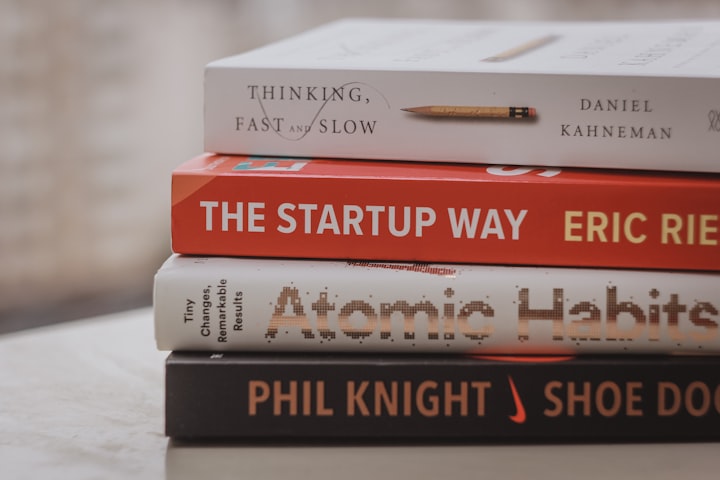Make Tiny Changes For Remarkable Results
4 simple steps from Atomic Habits to get the life you want

Everyone has this moment at some point where you want to change some aspect of your life. Maybe you want to quit smoking or eating unhealthily, or you want to pick up reading and exercising regularly. Or maybe it’s something as simple as waking up a few minutes earlier and journaling for a bit. We all have these moments.
Sometimes we get the motivation for these right around new year’s. In fact, new gym subscriptions are at their highest right at the beginning of the year with hundreds of people working on their new year’s resolutions. But how many of us actually stick with these changes?
Chances are, most of us do too much too fast and end up burning out, unable to continue that habit any more.
The differences, though, between those who stick to their habits and those that don’t, is not just determination or discipline, but rather their environment and the size of their habits. Smaller, bite-sized improvements of just 1% per day are the key to changing your life, not major improvements. To read more about this phenomenon, take a look at this article I wrote.
But this is just the size of those habits. How do we actually implement them? James Clear, in his book Atomic Habits, outlines a four-step process to building new habits:
1. Make it obvious
2. Make it attractive
3. Make it easy
4. Make it immediately satisfying
And the complete opposite for breaking bad habits:
1. Make it invisible
2. Make it unattractive
3. Make it difficult
4. Make it unsatisfying
These steps are based on our natural inclinations as humans and are quite simple, though not always easy to implement in our daily life.
#1 Make it obvious
Your environment is filled with cues that trigger some sort of action or craving in your brain. Take scrolling through social media, for example. Think of how you feel when you open your phone and notice that notification or app icon, even if your original intention had nothing to do with using social media, you just wanted to check the time real quick. When you notice these cues, your brain induces a sort of craving for that action, simply because that action is now associated with whenever that cue exists.
To build healthy habits, you need associated cues all around you with these habits.
Let’s say you’re trying to build the habit of doing yoga in the mornings. A way to make this obvious and trigger that habit would be to leave a yoga mat unrolled the night before ready to go, so when you wake up and see that mat, you will want to do yoga. Obviously, the effect won’t be instant, but it will compound over the long term. The first time you ever saw a social media icon didn’t give you that instant response to use it. And maybe not even the first 20 or 30 times. But eventually, that cue becomes ingrained in your mind until it becomes natural to just do that action.
Another way to make it obvious is the practice of habit stacking. Habit stacking is when you schedule one habit after another rather than scheduling a habit for a time and place, using this framework provided in the book
After I do [current habit], I will do [new habit].
A way to implement this could be to say “After I change my clothes for bed, I will journal for 5 minutes.”
Using this to stop bad habits would be to make them invisible, rather than obvious. If you have trouble grabbing a snack whenever you head downstairs, chuck all your chips or chocolates into a cabinet rather than leaving them out in the open. If you have trouble with social media for procrastinating, throw your phone to the other end of the room. Make these cues invisible.
We want to get to the point where we need to put as little effort into making that decision as possible, and habits provide us with that shortcut. They give us the ability to be more disciplined, simply because we don’t have to use our conscious effort to control our desires and cravings.
#2 Make it attractive
Humans are always looking for some sort of reward. Certain actions that we do can release dopamine, a chemical that gives us the sensation of pleasure. But studies find that the anticipation of reward gives you just as much dopamine as the reward itself after a while.
The book describes gambling addicts, for example, who get a surge of dopamine right before they place a bet, not after or during the game. Whenever you predict that something will be rewarding, your brain anticipates that and releases the dopamine beforehand.
And we can use this to our advantage.
Building temptation
A way to do this is combining something you already know you enjoy, drinking your morning coffee for example, with a habit you want to build, like writing every morning.
After finding these two actions, make it so you only drink your morning coffee if you are sitting someplace ready to write for the next while. This way, your brain comes to link that pleasure for morning coffee with writing, and you have an increasing temptation to write each morning.
Family and friends
Humans, a lot of the time, tend to value things that the people around us value. We share many ideals and goals with friends and family, and the culture we exist in determines what is attractive to us.
One of the most effective means of building new habits is to change this culture. Surround yourself with people for whom your desired behaviours are the norm, and you already have something in common with the group.
Say you want to build a running habit, for example. So you can surround yourself with people who run regularly or want to at least. But if all these people are proper gym rats and you are a bit of an introverted nerd, it can be really daunting to go, to the point where you might just skip it altogether. Instead, find groups that you have something in common with so that you’re more inclined to go again time after time.
If our behaviours get approval and respect, chances are we’ll find them more attractive and repeat them.
Reframing actions
Often, when doing something like running, we will prepare ourselves by saying “I need to do this run in the morning.” Instead, James Clear proposes that we instead frame it as “I need to build endurance and speed.” When it comes to bad habits like spending too much money, instead of saying “I need to spend less,” frame it as “spending less now means I get a better quality of life later.”
These small changes in how we think about actions can have a major impact on their attractiveness and our willingness to do them.
#3 Make it Easy
One of the main reasons we don’t do the things we want to is because they take a fair bit of effort to get started. We’re often stuck in this place where we just plan things out, but never actually get around to them because we convince ourselves we’re making progress by planning it. Making it easy here refers to making it so that you have no need to plan.
Reducing friction
A way to do this is to focus on reducing friction in your life. Friction here refers to the issues that stop you from doing what you want. Reducing friction to make good habits easier is one of the best concepts I’ve been able to apply in my daily life. Take getting out of bed as soon as you wake up. What stops you from doing that? For me, it was planning my day out before I got up. I convinced myself that I was being productive by staying in bed because I was planning what I would have for breakfast, what work I would start off with, and more.
Atomic Habits focuses on reducing this friction, and so I used ideas from it to inspire my own methods. Instead of planning my day out in the mornings, I keep a little notepad next to my bed that I fill in with details of the next day right before I go to bed. That way, I have no reason to stay in bed the next morning. Another way to reduce friction in my life has been to keep an exercise mat next to my bed the night before, with a 20–30 minute long exercise video open on my laptop. That way, all I need to do is quite literally roll out of bed onto the mat, and press like two buttons before I’m exercising.
While these changes seem really incremental and not really impactful, they are really helpful. In fact, since I’ve implemented these, I have stuck to my morning and nightly routines every day apart from just one or two, which is in itself a major improvement for me.
The Two-minute rule
Another way to make tasks easy is to just do them for a short period of time. The two-minute rule puts forth that when you are starting a new habit, it should not take longer than two minutes to complete. If you want to go to the gym more often, tell yourself you’re just going to go there for 2 minutes. Go to the gym and show up, and once you’ve done 2 minutes of exercise give yourself the excuse to leave.
Chances are, once you’ve shown up a few times, you’ll consider staying for 5 minutes instead of 2, and then 10, and then 20 until you’re up to where you wanted to be. And even if you do just stay for two minutes that’s already better than where you were before.
#4 Make it immediately rewarding
We always want instant rewards for doing tasks, and usually “what is immediately rewarded is repeated, while what is immediately punished is avoided.” Consider that hit of dopamine you get scrolling endlessly through social media or going through the McDonald’s drive through. It’s that dopamine that makes it so easy to repeat bad behaviours, but we can use it to our advantage.
Productivity YouTuber Ali Abdaal mentions that he implemented this in his gym routine, going to the spa and reads for a bit to relax after his workout, giving his brain that instant reward it craves and making these good habits so much easier.
Final thoughts
This book is an incredible one and it has genuinely had a major impact on my life. This article was just a short summary of some key points, so I would encourage all of you to read this book and implement its suggestions. A final thing I wanted to mention was what happens when you inevitably deviate from these habits?
One thing that the author mentions is that you should essentially scrap that day and get back into the rhythm as soon as you can. You are just human, after all, and we all make mistakes sometimes, but the key is to not let those mistakes compound and become bad habits.
This article was first published on Medium






Comments
There are no comments for this story
Be the first to respond and start the conversation.